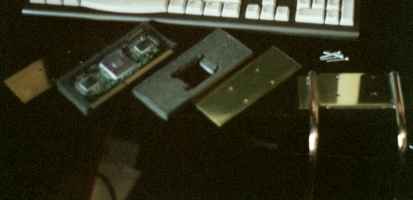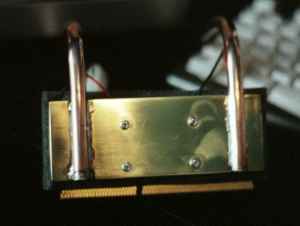Peltier Cooling
Introduction
Even with perfect water-cooling, it is not possible to cool the CPU to below room temperature, which is necessary to achieve really big overclocks. There are several methods of doing this, but the simplest method is to use Peltier heat pumps. There is very little information about what they are or how they work available on the Internet, so I have written a short explanation.
There are several points that must be considered when designing a Peltier system, in no particular order:
- Firstly, the cooling power provided by the Peltier must be greater than the heat to be removed from the CPU; for really good cooling at least twice as much cooling power as heat generated, which for my Athlon means two 72W devices are sufficient.
- The temperature the CPU will be cooled to is determined by the amount of extra cooling power there is above the amount of heat produced by the CPU, and by the amount of heat that leaks into the CPU from outside (assuming it is cooled to below ambient temperature). The temperature will stop falling when the amount of excess cooling power is equal to the rate of heat leaking in. This means that theoretically you could cool the CPU to absolute zero with a Peltier if you perfectly insulated the CPU, but of course this is impossible in reality.
- Condensation will form on anything in contact with the air if it is below a certain temperature determined by relative humidity. This requires that you insulate the cooled areas from air, which luckily coincides with the need to keep heat out, described above. Alternatively you could limit cooling to no less than ambient temperature, for which some sort of temperature control is desirable (units are available that do this).
- You must keep the hot side of the Peltiers cool, as they create a temperature difference between the two sides - it is no good having the cold side 20oC cooler than the hot side if the hot side is at 80oC! Peltiers themselves create massive amounts of heat (about 90W each for my 72W devices), so I have to deal with over 200W of heat somehow. Fortunately my water-cooling system can cope admirably. Air-cooling will work, but not only will it cool less, but it will also dump all the heat inside your case where it will make a mess of all your other stuff!
- Peltiers are more efficient at lower voltages, so it is better to have more Peltiers running from low voltage to get the same cooling power because they will generate less heat themselves. This is another fortunate coincidence because many Peltiers are rated at 15V, but can be run from the 12V rail of a computer PSU more efficiently. Of course you need more Peltiers to achieve the same cooling power (graphs of cooling power versus supply voltage should be available from the Peltiers' manufacturer).
- All the power they use will almost certainly require a dedicated PSU, and even if your existing PSU can supply enough power it is still better to have a second one because the heavy load will make the outputs of the PSU less clean.
Design
First, the power produced by the CPU must be known. This can be estimated by taking the power at default speed and core voltage (from the datasheet on the manufacturers website, AMD in my case), and plugging them into this equation:
- Pnew = power at overclocked speed and voltage in Watts.
- Pold = power at default speed and voltage in Watts.
- Fnew = overclocked speed in MHz.
- Fold = default speed in MHz.
- Vnew = overclocked core voltage in Volts.
- Vold = default core voltage in Volts.
Note that the voltages are squared.
Next the (theoretical) CPU temperature can be calculated. The cooling power from a Peltier decrease linearly from maximum (Qmax) when there is 0oC temperature difference between the hot and cold sides, to nothing when the temperature difference is equal to DTmax (normally around 70oC). The temperature difference will be at such a value that cooling power = heat absorbed. Knowing this, it is possible to construct the following equation for CPU temperature:
- Thot = hot side temperature, which will depend on how well you can cool the Peltier. 30oC is not unreasonable for good watercooling.
- DTmax = maximum temperature difference across Peltier, which should be given by the manufacturer.
- Pnew = power output of CPU at overclocked speed and voltage.
- Qmax = maximum cooling power of Peltier, which should be given by the manufacturer.
- Tcold = temperature of cold side (approximately equal to CPU temperature).
The actual CPU temperature will never get quite this cold because this equation does not take into account stray thermal resistances (thermal paste, coldplates and such), and because of imperfect insulation (as mentioned in the list at the top of the page).
Putting it all together
I have used blocks of foam to insulate the CPU from ambient air, which not only helps stop heat getting in, but also prevents nasty condensation forming out of the air. The foam I used is good because it is very squishy, allowing a tight fit of all the bits without too much pressure.

Above you can see the parts for the first really successful setup I used. It consists of the CPU sandwiched between two lumps of foam, all held in place by two brass plates, one of which is also the coldplate to which the Peltiers are attached. The waterblock sits on top of the Peltiers and the whole lot is bolted together tightly to ensure the CPU is in good contact with the coldplate.

It worked, but there were several factors limiting the temp to only just below ambient at full CPU load:
- The AT PSU I use to power the Peltiers was not supplying a high enough voltage to the devices (about 5.4V).
- The brass backplate was becoming cold, indicating that heat was leaking in that way.
- The steel bolts used to hold everything together provide a path for heat to flow from the waterblock straight to the coldplate.
It turned out that the first problem was because there must be a minimum current drawn from the 5V rail of the PSU before the full 12V appears. This was solved by using a third Peltier drawing from the 5V rail, pushing the 12V rail up to 11V.
I replaced the brass backplate with the plastic cover I removed from my Athlon and thankfully kept! I had to modify it slightly to make it fit with the other components.
Unfortunately there is nothing I can do about the steel bolts at the moment, because I cannot find nylon bolts in the correct size. Since the negative affect of the bolts seems to be small I will worry about it at a later stage.